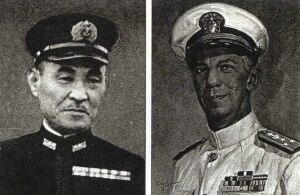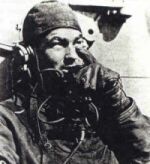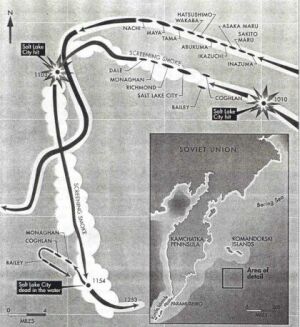|
By 10 a.m. the American task group had been under attack for more than an hour, and the constant firing and the near misses had begun to disrupt some of the machinery aboard Salt Lake City. The ship developed steering problems and began veering to starboard. The erratic change in direction convinced the Japanese that the cruiser was in trouble, and they began to press the attack. By then McMorris wanted to break off the engagement, and at 10:10 the situation worsened when a Japanese shell penetrated Salt Lake City's main deck, passed through the chain locker and exited the starboard side below the waterline. The shell failed to detonate, but the underwater hole caused Salt Lake City to settle a bit in the bow, though she maintained speed. McMorris ordered Bailey and Coghlan to take up positions near the ship's stern. The destroyers started laying a smoke screen, and within a few minutes, a thick cloud of smoke hid Salt Lake City amid the smoke and loosed a salvo as soon as they got one. The shells landed so close to the American ship that some officers mistakenly believed the Japanese must have been equipped with radar. Dale and Monaghan also began laying down smoke, but the Japanese gunners continued to direct salvos at the American cruiser.
At 11:03 an 8-inch shell hit Salt Lake City below the waterline on the port side and passed through one fuel tank before exploding in another. "When the ship was hit, it shook from stem to stern and felt like it was literally picked out of the water," a crew member recalled. Damage control parties worked to plug the hole in the ship's side, but a large amount of water had already flooded into the bow. By the time the cold water reached the engine room, Salt Lake City had listed slightly to port and begun to slow. Despite the numbing cold and gobs of oil that clogged the pumps in the engine room, the crew worked to stabilized the damaged ship.
Topside, the gunners continued to fire whenever a hole in the smoke screen gave them a clear view of the enemy, but with ammunition running low for the aft guns, the crews had to fire one gun at a time instead of salvo. The armor-piercing ammunition was almost gone, and Salt Lake City began to fire high-capacity shells, which like the armor-piercing ammo, did not have shell dye (the Japanese used shell dye to identify their fall of shot and adjust their fire). When the high-capacity shells exploded on the water, they looked like bombs dropped from airplanes. Just after the first of those shells exploded near them, Maya and Nachi began to spray the sky with anti-aircraft fire, convinced that they were under aerial attack.
While the Japanese fired at nonexistent aircraft, the crew of Salt Lake City struggled to get ammunition to the aft batteries. The forward magazines still had plenty of shells, but the forward guns could not bear on the Japanese ships. Two-man crews therefore began setting the 256-pound shells on hand dollies and wheeling them aft, a job made even more difficult by the ship's list and the jostling as the captain made sudden course changes to avoid enemy shells.
The Japanese heavy cruisers continued to close on the American ships, and as the range shortened, their chances of scoring a killing hit increased. Flight was Salt Lake City's only hope---and then all hope suddenly seemed to vanish with the turn of a valve. The cruise's crew had been reducing the ship's list by flooding empty fuel tanks when someone turned the wrong valve and poured sea water from one of the flooded tanks into the ship's boiler, snuffing out the fires. Salt Lake City lost power and drifted to a stop. Rodgers used the last few minutes of drift to turn the vessel so that all of the cruiser's guns could bear on the approaching Japanese. The situation was desperate. On the bridge, Bitler turned to the captain, quietly shook his hand and said, "Well, I guess this is it."
Rodgers asked for a cup of coffee and remarked, "If I'm going into the cold water, I want something warm in me."
Some remember Rodgers giving the order to abandon ship and immediately countermanding it. Instead, he made preparations for a last-ditch fight. The crew used old-fashioned muscle power to turn the turrets toward the approaching Japanese and waited for the enemy ships to emerge from the smoke screen.
McMorris, aboard Richmond, was also determined to make the Japanese pay dearly for Salt Lake City. He had Richmond move closer to the stricken cruiser, intending to take off her crew. Dale continued to maintain the protective smoke screen, but McMorris ordered the other three destroyers to make a torpedo attack on the Japanese ships. They would have to steam some distance to get close enough, all the time within range of the Japanese heavy guns---and well aware that a single 8-inch shell could break a destroyer's back. It was a forlorn hope, but the suicide run might gain enough time for Salt Lake City's crew to restart the ship's engines.
Bailey led Coghlan and Monaghan away from the smoke that protected Salt Lake City and steered directly for the approaching Japanese cruisers. With ever Japanese gun trained on them, the three puny destroyers held course unflinchingly. "The shell splash and explosions looked like Niagara Falls about 10 to 15 feet off the fantail," one man aboard a destroyer recalled.
As the Japanese gunners adjusted their ranges, the American destroyers managed to keep just ahead of them. The men on the Salt Lake City watched in awe and admiration. Worthy Bitler, a Civil War buff, commented, "Pickett's Charge had nothing on them." The Japanese officers, too, admired the gallant action. One Japanese officer noted, "I do not know how a ship could live through the concentration of fire that was brought to bear on the leading destroyer."
The leader was Bailey, and as the destroyers approached torpedo range, a shell struck her on the starboard side. It killed four men outright, mortally wounded one and seriously injured a half-dozen others.
The captain ordered the torpedoes launched from 10,000 yards. As the torpedoes knifed through the water, the Japanese ships began changing course to deny the other destroyers clear shots, even as they continued firing at the Americans. One shell hit Bailey and skidded to a stop on deck without exploding. The crew simply rolled the dud over the side.
Aboard the Japanese ships, Admiral Hosogaya had decided to break off the action. His fuel was low and ammunition was said to be "below the minimum prescribed by doctrine." Furthermore, the one Japanese scout plane in the air was for some reason unable to communicate Salt Lake City's desperate situation. Hosogaya was also convinced that American bombers would arrive on the scene at any minute---fears reinforced by the shells from Salt Lake City that the Japanese had mistaken for bombs. Actually, McMorris had received a message from headquarters that American bombers would not arrive for at least two more hours. In fact, the Battle of Komandorski Islands was the last action during the Pacific War to take place between large surface ships without the participation of aircraft or submarines, since Nachi's spotting plane had been no help.
Behind the smoke screen, the crew of Salt Lake City had managed to purge the fuel lines just after the destroyers had begun their run. Once the three small vessels that had scared off the Japanese cruisers returned, McMorris led his battered task group back to port. The Japanese would not try to reinforce Attu and Kiska by surface convoy again.
The casualties on both sides were light after nearly four hours of battle. The crew of Salt Lake City had looked death in the face and survived. One American officer credited their success to luck, saying: "It was like flipping a coin over and over again for three hours and a quarter, double or quits. And every single time it came up heads."

 "Lieutenant Commander David D. Hawkins summed up the battle in Salt Lake City's log: "This day the hand of Divine Providence lay over the ship. Never before in her colorful history has death been so close for so long a time. The entire crew offered its thanks to Almighty God for his mercy and protection."
"Lieutenant Commander David D. Hawkins summed up the battle in Salt Lake City's log: "This day the hand of Divine Providence lay over the ship. Never before in her colorful history has death been so close for so long a time. The entire crew offered its thanks to Almighty God for his mercy and protection."
Perhaps the best comment about the Battle of the Komandorski Islands was that made by Bertram Rodgers: "Fooled them again, Worthy!"
|


